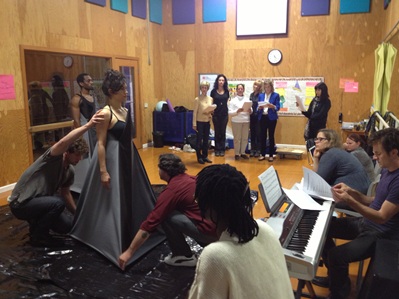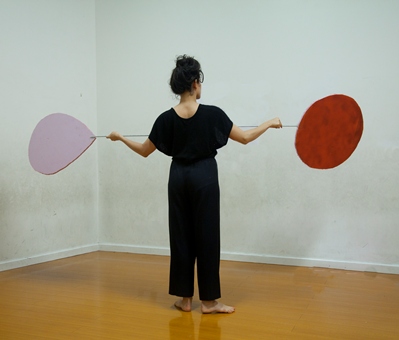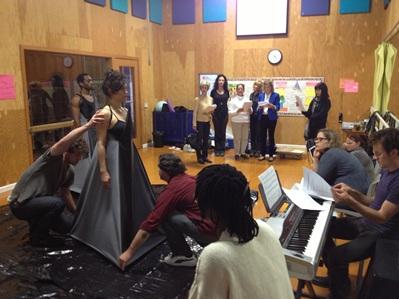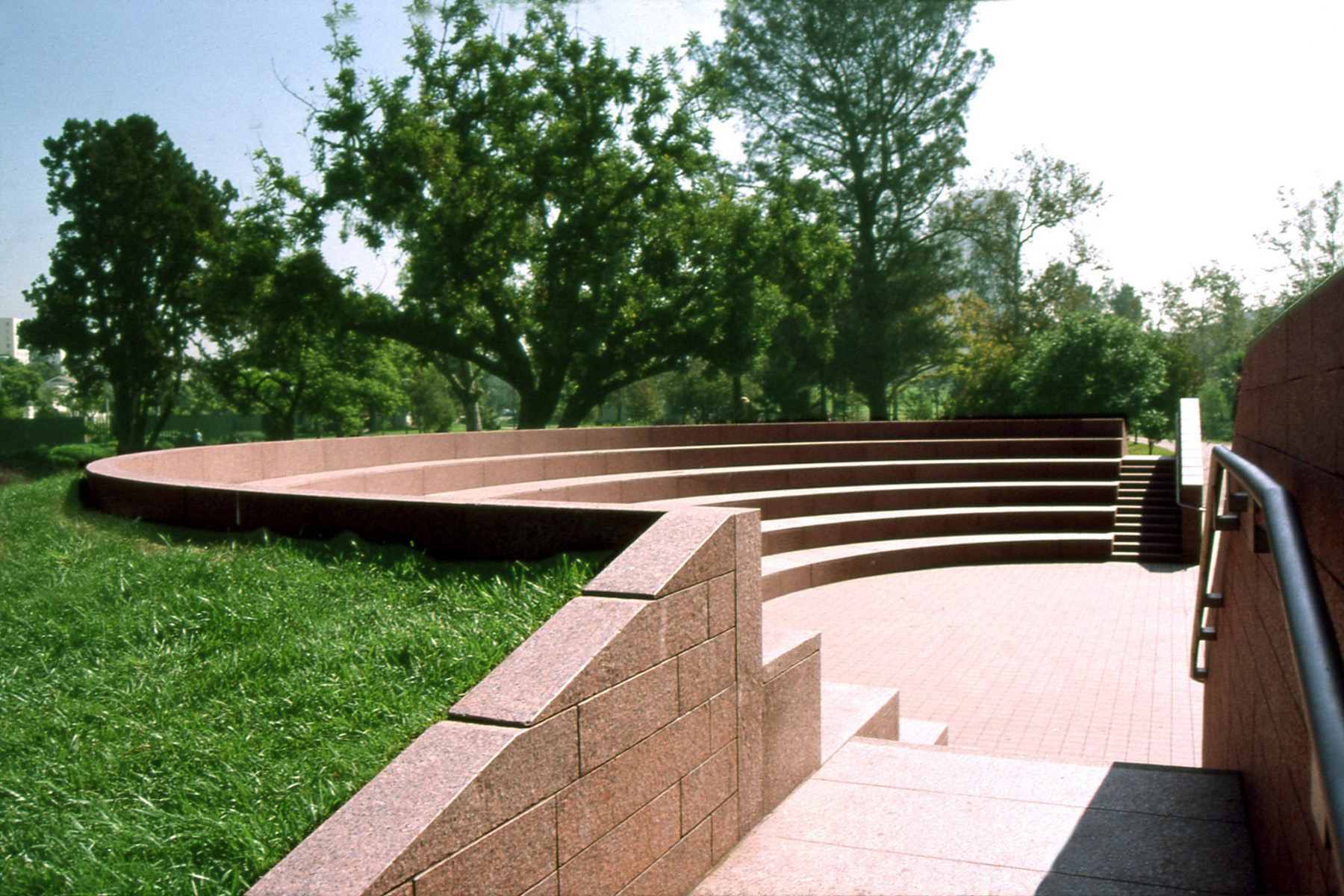Artist Liz Glynn's series, [de]-lusions of Grandeur, closes this Saturday with a final performance, The Myth of Permanent Material, which focuses on Donald Judd's Untitled (for Leo Castelli) a 1977 sculpture comprising five concrete cube-like forms currently on display near the tar pit in Hancock Park. Glynn’s performance plays around the idea of potentially recreating Judd’s work. Unframed wraps up the performances with an interview with Glynn conducted by LACMA's social-media manager Maritza Lerman Yoes.
Maritza Lerman Yoes: I'm excited (and sad) to be witness to your final performance as part of your [de]-lusions of Grandeur series at LACMA. How does it feel to be wrapping up this performance cycle?
Liz Glynn: It will be strange not to be at LACMA so often. Over the past year, I’ve worked with a number of people across the staff—security guards, conservators, registrars, and curatorial assistants—and it’s hard to walk across the campus without seeing someone I know.
 Rehearsals for Liz Glynn's The Myth of Getting It Right the First Time
Rehearsals for Liz Glynn's The Myth of Getting It Right the First Time
MLY: Can you tell me what you will be doing with the Donald Judd work?
LG: This action, The Myth of Permanent Material (after Donald Judd) delves into the conservation issues surrounding Judd’s Untitled (for Leo Castelli), 1977. This is one of Judd’s earliest works in concrete, and over the time, the material has eroded, and been subject to the typical wear and tear of a sculpture installed outdoors on public view.
In LACMA’s curatorial files on the piece, there has been some debate about whether the work should be refabricated, though this issue proves complicated given Judd’s uneven history regarding the conservation of his work during his lifetime. I have recreated the formwork necessary to recast the concrete piece, and we’ve hired a cement mixer. We will debate the arguments for and against recasting the work, and the outcome of the debate will determine whether the concrete is poured.
MLY: What is the significance of the Donald Judd given that this is your last performance?
LG: Donald Judd’s work, and particularly his early plywood pieces, was one of my first entry points into making sculpture, so personally, it’s a fitting end. On a more conceptual level, I think the question of permanence, and the implications of creating something permanent, is one the most significant issues all of the performances in the cycle have touched on in one way or another.
MLY: How did you pick the five works for your five performances?
LG: The initial impetus for the project was to explore issues of human ambition, monumentality, and permanence through LACMA’s collection. I began by identifying the works in the collection that might qualify as “monumental,” and started researching each through academic journals, catalogues, LACMA’s files, and in conversation with members of the curatorial and conservation staff. Rodin and Calder initially both seemed like outliers, as I had initially wanted to focus on Minimalist works, but the research unearthed some unexpected parallels to contemporary sculpture.
MLY: Why were all five pieces by men who did monumental work?
LG: Interesting, the only "monumental" work by a female artist in LACMA’s collection is the amphitheater by the artist Jackie Ferrara. Many visitors don’t realize the structure is in fact an artwork. I did consider this piece early on, but felt that the issues I was interested in exploring were better expressed in other pieces from the collection.
MLY: How complicated was it to arrange materials for your performances?
LG: Scale is a logistical challenge, particularly in the cases of Judd and Serra. My initial concept for the Serra work was to bring the weight of Band, 2006, in sand, and work with participants from the museum audience to move this weight to the site where the work was installed. However, no sand and gravel distributor in the greater Los Angeles was able to bring this quantity! I opted to order the weight of one of the ten plates (18 tons), and this still required 2 trucks.
Performance also functions with a completely different sense of temporality than monumental sculpture. While artifacts remain from the performances, such as the plaster sculptures created during The Myth of Singularity or the theatrical props from The Myth of Getting it Right the First Time, the materials must be designed to be mobile.
 Rehearsals for Liz Glynn's The Myth of Getting It Right the First Time
Rehearsals for Liz Glynn's The Myth of Getting It Right the First Time
MLY: What did you learn about museum infrastructure?
LG: The museum is a fundamentally social organism, and much of its history is held in the minds of its staff. While the museum appears monolithic from the outside, in fact, it is the product of an incalculable number of decisions made by talented individuals every day. It’s a highly evolved network, and yet few of the rules of engagement are formalized on paper.
A lot of my best research came from conversations with members of the staff.
Stephanie Barron’s Museum as Site show was a significant influence on this project and it was great to get her perspective on how the expansion of the museum’s staff and departmental structure has changed the process of curating and producing an exhibition since the early 1980s. LACMA today has a massive infrastructure, and the curatorial department is only one of many moving parts in the production an exhibition.
MLY: What's behind the title of the entire series and the individual performances?
LG: The performances seek to disrupt some of the grander ideas about permanence and the artistic genius traditionally associated with monumental work. I wanted the audience to think about not only the process of construction, but also the process of maintenance, and the continued life of a sculpture after it leaves the studio. As a sculptor, I spend most of my time in the world of production, but as a museum visitor, one only access the artwork in its finished state. I wanted to merge the two worlds, and try to forge a continuum between them. I am interested in what happens to these large works physically, what this says about cultural value, and the meaning of an artwork can shift over time.
MLY: What's next for you?
LG: I’m very excited to be working with José Luis Blondet to document the project in book form. Rather than a traditional catalog, the book will serve as a collection of fragments: images, texts, and interviews compiled from performers, members of the museum staff, and my own research.




